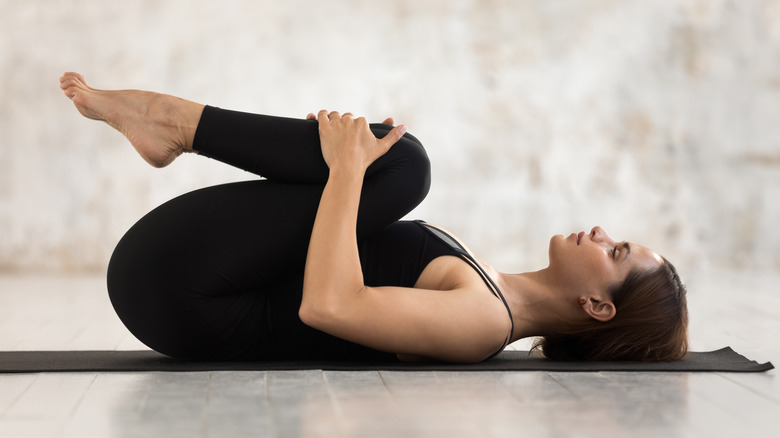Movements To Help Relieve Trapped Gas
Gas is produced in the intestines as a result of the digestion process and is typically released from the body through burping or passing gas, per Medical News Today. Passing gas is a normal part of digestion; however, when gas gets trapped in the intestines, it can be very uncomfortable and can sometimes interfere with daily activities. The feeling of bloating, pressure, and discomfort in your abdomen can also cause embarrassment, particularly if the gas is accompanied by flatulence or belching. Other common symptoms of trapped gas include cramps, sharp pains, and a feeling of fullness. In some cases, trapped gas may also lead to anxiety or stress as you worry about the possible causes and outcomes of your symptoms.
Fortunately, there are several ways to relieve trapped gas, including changes to your diet, lifestyle modifications, and simple home remedies such as abdominal massage, according to the Mayo Clinic. If your symptoms persist or worsen, seeking medical attention is important, as they may be a sign of a more serious condition requiring treatment.
What causes trapped gas?
According to Medical News Today, one of the causes of trapped gas is swallowing air. When you eat or drink, you can accidentally swallow air, which can lead to gas buildup in your intestines. Chewing gum, drinking carbonated beverages, and smoking can also cause you to swallow more air than usual. This can result in more gas being produced and an increased likelihood of it becoming trapped.
Another factor that can cause trapped gas is the consumption of certain foods that contain carbohydrates. They include beans, whole grains, cabbage, and broccoli. If certain digestive enzymes are absent in the small intestines, some foods high in fiber and carbohydrates aren't digested properly. Instead, they'll ferment in the intestines, producing gas as a byproduct, per Johns Hopkins Medicine. Certain medical conditions can also contribute to trapped gas. For example, if you have irritable bowel syndrome (IBS), you may be more prone to experiencing gas and bloating.
Wind-relieving pose
Wind-relieving pose, also known as Pawanmuktasana in Sanskrit, is a yoga posture that can help relax the abdomen and buttocks, according to Healthline. To practice the wind-relieving pose, lie down on your back with your legs extended at 90 degrees. Next, bring your knees toward your chest, supporting them with your arms around your knees, and interlace your fingers, holding your knees in place. Then, lift your head and neck and curl them inward toward your legs. Hold the pose for 20 seconds to a minute and then release. You can also choose to do the pose with just one leg at a time. Healthline also recommends gradually increasing the hold time to 1 minute as you gain momentum.
The wind-relieving pose can also help stretch your lower back and helps stimulate digestion, according to Yogapedia. It's a gentle pose that puts pressure on the abdomen to help relieve gas, says Medical News Today.
Abdominal self-massage
Abdominal self-massage is a simple technique that can help relieve trapped gas and promote digestion. To perform an abdominal self-massage, the University of Michigan recommends lying down on your back with your knees bent and your feet flat on the ground. Use your fingertips to massage your abdomen in a clockwise circular motion. Start at the lower right side of your abdomen near the pelvic bone and work your way up to the ribs, across to the left side, and down to the lower left side, and back upward toward the belly button. Spend around 1 minute for each side of the abdomen and repeat for 10 minutes.
Generally speaking, massages can help relieve constipation by increasing bowel movement and decreasing the transit time of food in the colon, according to a 2011 review published in the journal Nursing Times. It can also help decrease pain and discomfort.
Child's pose
Child's pose is a yoga posture that is often used as a resting pose between more active poses, per the Yoga Journal. The pose, also known as Balasana in Sanskrit, is a great way to gently stretch the back and shoulders. To come into Child's Pose, kneel on the floor with your knees separated and hip-width apart. Next, sit back on your heels with your toes together, then slowly fold forward, bringing your chest to rest between your thighs. Broaden your pelvis, slowly extend your arms forward, and rest with palms on the floor. Alternatively, you can also bring your arms back by your sides with your palms facing up. According to Medical News Today, your forehead should rest on the floor while the torso stays between the legs to put gentle pressure on the abdomen. The source advises taking deep breaths to allow gas to pass.
When to see a doctor
Trapped gas in the digestive system is a common and normal part of digestion. However, there are certain situations when you should consider seeing a doctor. If you experience severe or persistent abdominal pain, bloating, or constipation, it's important to seek medical attention. These symptoms can be a sign of a more serious condition, such as irritable bowel syndrome (IBS), celiac disease, or even colon cancer, per Medical News Today. If you have a family history of any of these disorders, you should also talk to your doctor about any symptoms you experience, including trapped gas.
Additionally, you should seek medical attention if you notice any changes in your bowel habits, such as diarrhea or blood in your stool. Finally, suppose you experience severe or persistent symptoms, such as fever. In that case, you should seek medical attention immediately, as these can be signs of a more serious condition that requires urgent treatment.






